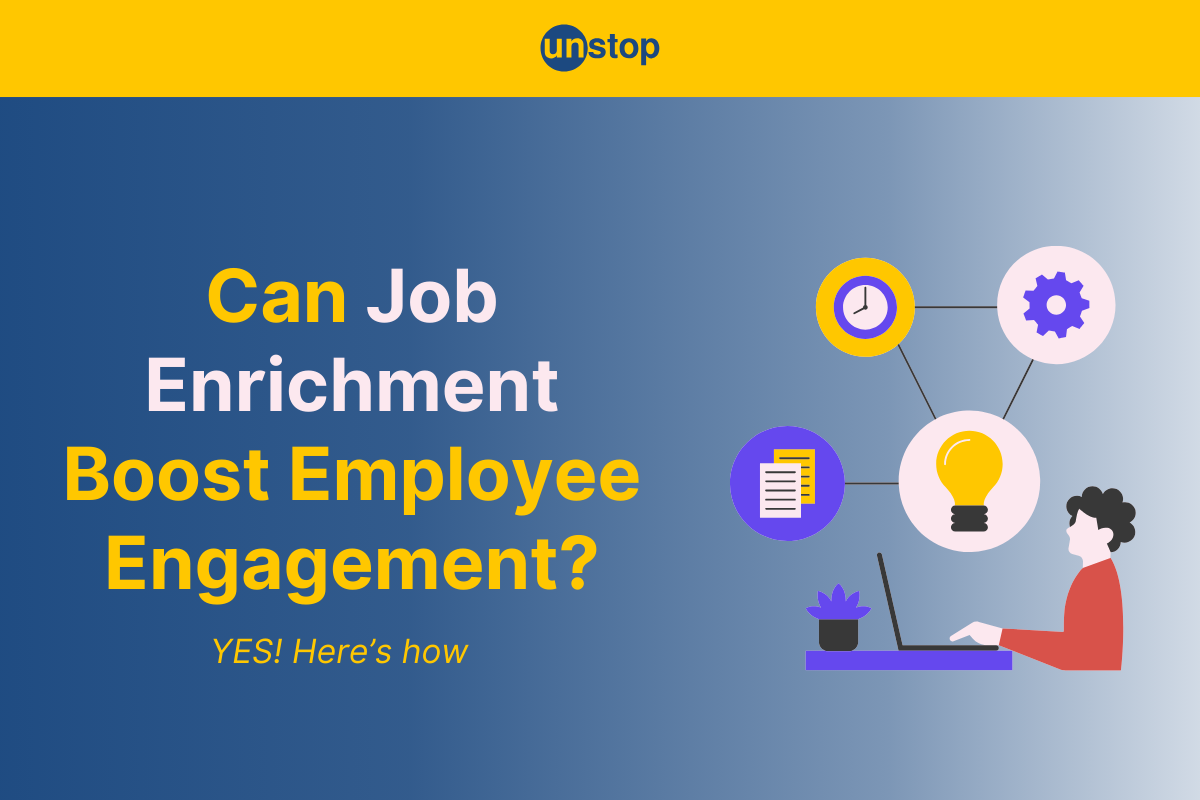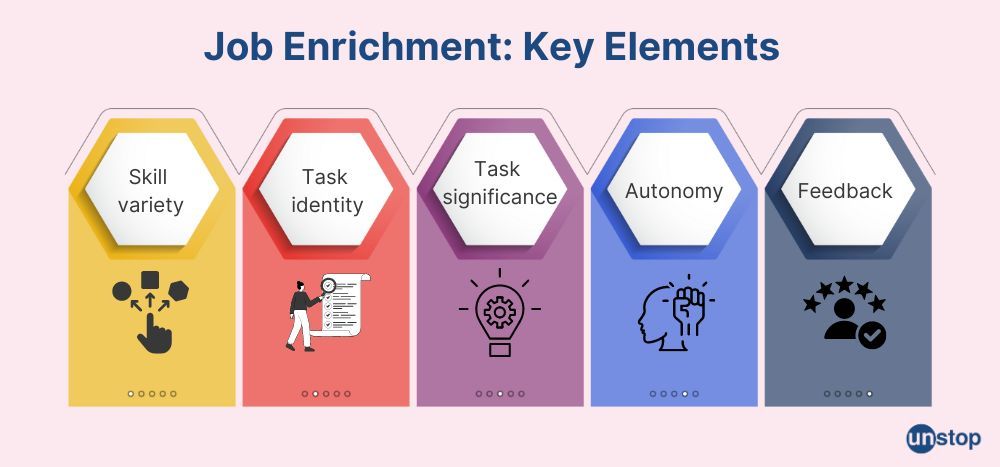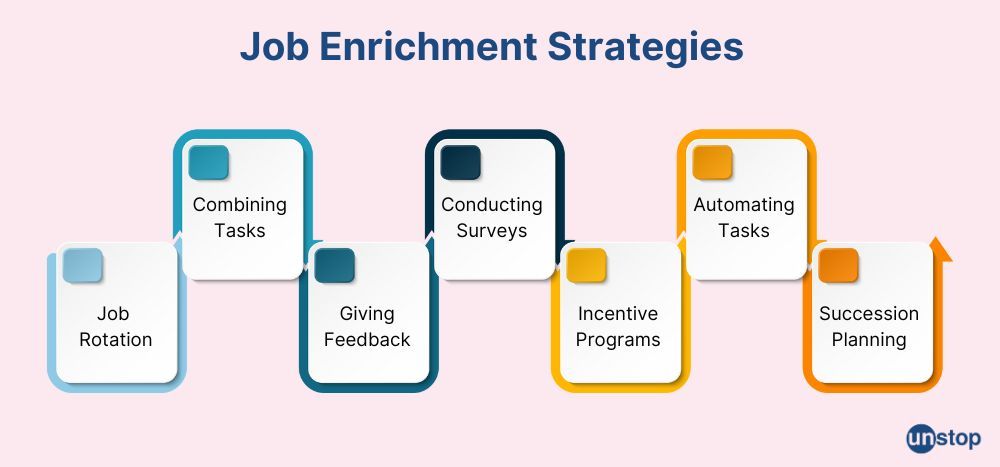- What is Job Enrichment
- Effective Job Enrichment Strategies
- Impact of Job Enrichment on Employees
- Challenges of Job Enrichment
- When to Pick Job Enrichment
- Job Enrichment Examples
- Final Remarks
- Frequently Asked Questions
Job Enrichment: Definition, Strategies, and Impact on Employees

A common complaint at work can be monotonous tasks that hamper growth. Job enrichment transforms mundane tasks into engaging experiences. By adding variety and responsibility, employees feel more motivated and satisfied. This approach not only boosts productivity but also enhances creativity in the workplace.
Companies embracing job enrichment see lower turnover rates and a more committed workforce. Dive in to learn more about this strategy and the benefits it offers both employees and employers alike.
What is Job Enrichment
Definition
Job enrichment is a job design strategy where an employee's job scope is increased by adding tasks that require higher-level skills and responsibilities. It aims to increase employee autonomy, control, and ownership over their work.

Herzberg's two-factor theory
Herzberg's two-factor theory plays a significant role in job enrichment. It posits that there are two sets of factors that influence employee motivation:
- Hygiene factors: These factors are related to job context and working conditions. They can lead to dissatisfaction if they are absent but do not necessarily motivate employees. Examples include salary, benefits, working conditions, and company policies.
- Motivators: These factors are intrinsic to the job itself and can lead to satisfaction and motivation. Examples include achievement, recognition, responsibility, growth, and advancement.
Job enrichment focuses on increasing the motivators in a job. By adding tasks that are challenging, meaningful, and provide opportunities for growth, organizations can enhance employee satisfaction and motivation.
Herzberg's theory suggests that simply improving hygiene factors (e.g., increasing salary) may not be enough to motivate employees. It is essential to address the motivators to create a truly fulfilling and motivating work environment.
Job Enrichment vs Job Enlargement
Job enlargement adds responsibilities at the same level without enhancing meaning. In contrast, job enrichment focuses on enhancing the meaning of work.
Here’s a quick look at how the two differ:
| Feature | Job Enlargement | Job Enrichment |
|---|---|---|
| Focus | Horizontal expansion of job duties | Vertical expansion of job responsibilities |
| Level of Authority | Remains the same | Increases |
| Skill Level | Remains the same | Requires higher-level skills |
| Motivation | Can increase satisfaction but may not be enough | Directly addresses motivational factors |
| Example | Adding more tasks at the same level | Giving employees more autonomy and decision-making power |
In essence: Job enlargement broadens the scope of a job, while job enrichment deepens it by adding more challenging and meaningful tasks. Both strategies aim to improve motivation but achieve it differently. Recognizing these distinctions helps organizations apply effective employee motivation strategies.
Effective Job Enrichment Strategies

Rotating Jobs
Job rotation encourages employees to experience different roles. This strategy provides diverse experiences and enhances skills. It prevents monotony, keeping employees engaged. Cross-training also emerges from job rotation. Employees learn multiple functions, enhancing team collaboration and flexibility.
Combining Tasks
Combining related tasks creates more meaningful work. This approach leads to a greater sense of ownership. Employees feel accomplished when they see how their tasks connect. Understanding the bigger picture boosts motivation. It helps individuals realize their contributions matter.
Sharing Employee Feedback
Regularly sharing constructive feedback is essential. Feedback fosters a culture of continuous improvement. Recognizing achievements boosts morale and motivation. Employees feel valued when their efforts are acknowledged. Constructive conversations can lead to personal growth.
Conducting Employee Surveys
Conducting regular employee surveys helps gauge engagement and satisfaction levels. Surveys help identify areas for job enrichment and improvement. Involving employees in decision-making processes increases engagement. Their insights shape effective job enrichment initiatives. Listening to employees promotes a positive workplace culture.
Automating Tasks
Automating repetitive tasks frees up time for meaningful work. This reduces workload and increases efficiency. Automation allows employees to focus on creative and strategic tasks. By streamlining processes, organizations enhance productivity while enriching jobs.
Creating Incentive Programs
Designing incentive programs that align with job enrichment goals motivate employees to embrace new challenges. For example, offering bonuses for completing training can encourage skill development. Tailoring incentives to meet the diverse needs of employees increases effectiveness. Some may prefer monetary rewards, while others might value recognition or additional responsibilities. Organizations should consider these preferences when creating programs.
Succession Planning
Organizations must integrate job enrichment into their succession planning strategies. This approach prepares employees for future roles while motivating them in their current positions. Employees who see a clear path to advancement often feel more engaged. They are likely to take on challenges and responsibilities that align with organizational goals. Developing talent internally helps ensure long-term success for the organization. It builds a committed workforce ready to step into key roles.
Impact of Job Enrichment on Employees
Increased Job Satisfaction
Job enrichment directly increases employee satisfaction. Enriched roles allow workers to connect more deeply with their tasks. This connection fosters a sense of belonging to the organization’s goals. Employees who feel valued tend to be more engaged in their work. Recognizing individual contributions boosts overall job satisfaction. Managers play a key role in this recognition. A supportive work environment encourages employees to thrive.
Greater Innovation
Employees thrive when they have more autonomy in their roles. When workers feel trusted, they take on more responsibility. This sense of ownership encourages them to be innovative. They often come up with creative solutions to problems. A marketing manager who decides how to approach a campaign can lead to fresh ideas.
Reduced Turnover and Absenteeism
Job enrichment initiatives lead to lower absenteeism and turnover rates. Employees who experience higher workplace satisfaction are less likely to leave for other jobs. Satisfied employees show up consistently and contribute positively. Employers benefit from reduced hiring expenses when turnover is low. Improved employee retention translates into cost savings for businesses.
Personal Growth and Development
Job enrichment can provide opportunities for employees to learn new skills and develop their competencies. Taking on more challenging roles can open doors to career advancement. Success in a more enriched role can boost employee confidence and self-esteem.
Challenges of Job Enrichment
While job enrichment offers many benefits, it also presents certain challenges:
Increased Workload and Stress
- Drawback: While job enrichment can make work more interesting, it can also lead to an increased workload and higher expectations. Employees who are given more tasks and responsibilities may feel overwhelmed, leading to stress and burnout.
- Impact: This can negate the positive effects of job enrichment, causing employee dissatisfaction and potentially leading to higher turnover.
Not Suitable for All Employees
- Drawback: Not all employees may desire or thrive under job enrichment. Some may prefer routine tasks and feel uncomfortable or stressed by additional responsibilities and decision-making power.
- Impact: For these employees, job enrichment could decrease job satisfaction and performance, leading to disengagement and potentially higher turnover among those who feel ill-equipped to handle the increased demands.
Potential for Role Ambiguity
- Drawback: Expanding the scope of a job can sometimes blur the lines of responsibility, leading to role ambiguity. Employees may be unsure about their new responsibilities or how they should prioritize tasks, which can cause confusion and inefficiency.
- Impact: Role ambiguity can lead to mistakes, decreased productivity, and frustration among employees who are unclear about their duties and objectives.
Cost and Time Investment
- Drawback: Implementing job enrichment often requires a significant investment of time and resources. Organizations may need to provide additional training, redesign job roles, and implement new processes to support enriched jobs.
- Impact: The costs associated with these changes can be substantial, and the return on investment may not be immediate, especially if the job enrichment program is not well-received by employees.
Resistance to Change
- Drawback: Employees and managers alike may resist the changes required for job enrichment. Employees may be comfortable with their current roles and reluctant to take on new responsibilities, while managers might be concerned about losing control or having to manage a more autonomous workforce.
- Impact: Resistance to change can hinder the successful implementation of job enrichment and may require additional efforts to manage and overcome, such as communication strategies and change management programs.
Overcoming these challenges requires careful planning, effective communication, and a commitment to employee development. By addressing these issues, organizations can successfully implement job enrichment and reap its benefits.
When to Pick Job Enrichment
Job Enrichment should be chosen when the focus is on enhancing motivation, developing skills, preparing employees for future roles, improving retention, or encouraging innovation.
1. Enhancing Employee Motivation and Engagement
- Situation: When the goal is to boost employee motivation, satisfaction, and engagement, job enrichment is the better choice. By adding more meaningful responsibilities and opportunities for growth, employees can find greater purpose in their work.
- Example: A marketing assistant might have their role enriched by being given more autonomy to design and manage their own campaigns, thereby enhancing their sense of ownership and accomplishment.
2. Developing Skills and Preparing for Leadership
- Situation: If the organization aims to develop employees’ skills and prepare them for future leadership roles, job enrichment provides opportunities for learning and personal growth. This often includes decision-making responsibilities and opportunities to lead projects.
- Example: A project coordinator could have their job enriched by taking on the responsibility for leading team meetings, managing budgets, or developing project timelines.
3. Improving Employee Retention
- Situation: When employee turnover is a concern, and the organization wants to retain talent by making roles more fulfilling, job enrichment can help. Employees are more likely to stay with a company that offers them meaningful challenges and opportunities to grow.
- Example: A software developer might be given the chance to mentor junior developers or lead new product development initiatives, which can increase their engagement and reduce the likelihood of them seeking opportunities elsewhere.
4. Encouraging Innovation and Creativity
- Situation: Job enrichment is ideal when the organization wants to foster a culture of innovation and creativity. By giving employees more control and responsibility, they are encouraged to think critically, solve problems, and come up with new ideas.
- Example: An R&D engineer might have their job enriched by being tasked with identifying new market opportunities and developing product prototypes, allowing them to use their creativity and strategic thinking skills.
Job Enrichment Examples
- Google: Google is known for its innovative approach to job enrichment. Employees are encouraged to spend 20% of their time working on passion projects that align with their interests. This practice has led to the development of successful products like Gmail and Google Maps.
- Zappos: The online shoe retailer Zappos is another company that prioritizes job enrichment. They offer employees opportunities to rotate between different roles within the company, allowing them to gain new skills and experiences. This approach helps keep employees engaged and motivated in their work.
- Patagonia: The outdoor clothing company Patagonia is committed to job enrichment through its unique approach to employee development. They offer employees opportunities for outdoor adventures, such as surfing or hiking, to help foster creativity and innovation. This focus on work-life balance and personal growth contributes to a positive work environment and high employee satisfaction.
Final Remarks
Job enrichment is a game changer for your workplace. It boosts employee satisfaction and productivity while fostering empowerment and communication. By applying effective strategies and optimizing your organizational structure, you create an environment where everyone thrives.
Take action now. Assess your current job roles and identify areas for enrichment. Engage with your team to gather insights on their needs and preferences. Implement changes that resonate with them. You’ll not only see happier employees but also improved performance across the board. Start making these adjustments today for a more dynamic workplace tomorrow.
Frequently Asked Questions
1. What is job enrichment?
Job enrichment involves redesigning jobs to enhance employee satisfaction and motivation. It adds meaningful tasks, autonomy, and opportunities for personal growth.
2. How does job enrichment improve productivity?
By increasing engagement and satisfaction, job enrichment leads to higher productivity. Employees are more motivated and invested in their work, resulting in better performance.
3. What are effective job enrichment strategies?
Effective strategies include increasing task variety, providing opportunities for skill development, enhancing autonomy, and fostering a supportive work environment.
4. How does job enrichment impact employee satisfaction?
Job enrichment boosts employee satisfaction by making work more meaningful. When employees feel valued and challenged, they are happier and more committed.
5. Can job enrichment enhance communication within teams?
Yes, job enrichment promotes open communication by encouraging collaboration and feedback. Empowered employees are more likely to share ideas and support each other.
6. What role does organizational structure play in job enrichment?
An optimized organizational structure supports job enrichment by facilitating clear roles and responsibilities. This clarity allows employees to take ownership of their tasks effectively.
7. Is job enrichment suitable for all types of jobs?
While job enrichment can benefit many roles, its effectiveness varies by industry and position. Tailoring strategies to specific jobs ensures the best outcomes.
Suggested Reads:
I’m a reader first and a writer second, constantly diving into the world of content. If I’m not writing or reading, I like watching movies and dreaming of a life by the beach.
Login to continue reading
And access exclusive content, personalized recommendations, and career-boosting opportunities.
Subscribe
to our newsletter
Blogs you need to hog!

Organize Hackathons: The Ultimate Playbook With Past Case Studies

What is Campus Recruitment? How To Tap The Untapped Talent?

Lateral Hiring: A Complete Guide To The Process, Its Benefits, Challenges & Best Practices













Comments
Add comment